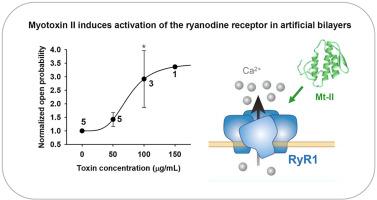Myotoxin II是一种蛇毒Lys49磷脂酶A2同源物,可诱导人工双分子层中ryanodine受体的激活
IF 2.4
4区 医学
Q2 PHARMACOLOGY & PHARMACY
引用次数: 0
摘要
毒蛇的毒害引起急性肌肉组织损伤(肌坏死)。一组重要的肌毒性成分包括催化无活性的Lys49磷脂酶A2同源物,其通过不涉及磷脂水解的机制破坏骨骼肌纤维质膜的完整性。然而,目前尚不清楚这些肌毒素的细胞毒性作用是否涉及其他机制。本研究将分离的钙释放通道(红嘌呤受体,RyR1)整合到人工脂质双分子层中,研究了肉毒蛇毒中Lys49磷脂酶A2同源物肌毒素II (Mt-II)的作用。Mt-II诱导RyR1的剂量依赖性激活。通道打开的可能性随着毒素剂量的增加而增加。在毒素处理期间,通道的最大电导保持不变。此外,对开放状态和封闭状态的分析表明,后者有轻微的毒素依赖性。这些发现表明,除了钙通过被破坏的质膜从细胞外空间流入外,钙离子也可能从内部储存中释放出来。然而,将C2C12肌管与RyR1拮抗剂丹曲林一起培养并没有降低Mt-II诱导的细胞毒性程度,这表明RyR1介导的胞质Ca2+的增加并不是这种毒素的整体肌毒性的原因。本文章由计算机程序翻译,如有差异,请以英文原文为准。

Myotoxin II, a snake venom Lys49 phospholipase A2 homolog, induces activation of the ryanodine receptor in artificial bilayers
Envenomation by viperid snakes causes acute muscle tissue injury (myonecrosis). An important group of myotoxic components comprises catalytically-inactive Lys49 phospholipase A2 homologs, which disrupt the integrity of the plasma membrane of skeletal muscle fibers through a mechanism that does not involve phospholipid hydrolysis. However, it remains unknown whether other mechanisms are involved in the cytotoxic action of these myotoxins. In this work, isolated calcium release channels (ryanodine receptor, RyR1) incorporated into an artificial lipid bilayer were used to study the action of the Lys49 phospholipase A2 homolog myotoxin II (Mt-II) from the venom of Bothrops asper. Mt-II induced a dose-dependent activation of the RyR1. The open probability of the channel increased with the dose of the toxin. The maximal conductance of the channel remained unchanged during the toxin treatment. Furthermore, the analysis of the open and closed states showed a slight toxin dependency of the latter. These findings suggest that, in addition to the calcium influx from the extracellular space through the disrupted plasma membrane, Ca2+ release from the internal stores may also occur. However, incubation of C2C12 myotubes in culture with the RyR1 antagonist dantrolene did not reduce the extent of cytotoxicity induced by Mt-II, suggesting that the RyR1-mediated increase in cytosolic Ca2+ does not contribute to the overall myotoxicity of this toxin.
求助全文
通过发布文献求助,成功后即可免费获取论文全文。
去求助
来源期刊

Toxicon
医学-毒理学
CiteScore
4.80
自引率
10.70%
发文量
358
审稿时长
68 days
期刊介绍:
Toxicon has an open access mirror Toxicon: X, sharing the same aims and scope, editorial team, submission system and rigorous peer review. An introductory offer Toxicon: X - full waiver of the Open Access fee.
Toxicon''s "aims and scope" are to publish:
-articles containing the results of original research on problems related to toxins derived from animals, plants and microorganisms
-papers on novel findings related to the chemical, pharmacological, toxicological, and immunological properties of natural toxins
-molecular biological studies of toxins and other genes from poisonous and venomous organisms that advance understanding of the role or function of toxins
-clinical observations on poisoning and envenoming where a new therapeutic principle has been proposed or a decidedly superior clinical result has been obtained.
-material on the use of toxins as tools in studying biological processes and material on subjects related to venom and antivenom problems.
-articles on the translational application of toxins, for example as drugs and insecticides
-epidemiological studies on envenoming or poisoning, so long as they highlight a previously unrecognised medical problem or provide insight into the prevention or medical treatment of envenoming or poisoning. Retrospective surveys of hospital records, especially those lacking species identification, will not be considered for publication. Properly designed prospective community-based surveys are strongly encouraged.
-articles describing well-known activities of venoms, such as antibacterial, anticancer, and analgesic activities of arachnid venoms, without any attempt to define the mechanism of action or purify the active component, will not be considered for publication in Toxicon.
-review articles on problems related to toxinology.
To encourage the exchange of ideas, sections of the journal may be devoted to Short Communications, Letters to the Editor and activities of the affiliated societies.
 求助内容:
求助内容: 应助结果提醒方式:
应助结果提醒方式:


